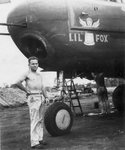daveT
Senior Airman
A civilian flying combat missions during WWII? It happened more than once. A civilian Technical Representative for North American Aviation Corporation named Jack Fox experimented with gun installations in the nose of B-25 Mitchell aircraft used by the U.S. Fifth Air Force during World War Two. Jack Fox also accompanied the early model B-25 Mitchells into combat with the 3rd Attack Group and often flew actual combat missions in New Guinea to see how his field modifications fared. Thus he earned the respect of all - engineers, pilots and ground crew. This story provides a detailed history of these efforts and how they contributed to winning World War Tw pen pdf to read the story. I welcome your comments
pen pdf to read the story. I welcome your comments
DaveT
DaveT


